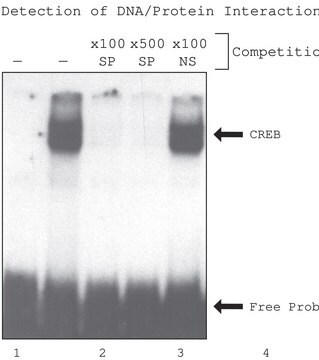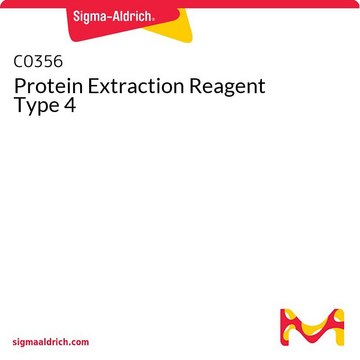P9599
Protease Inhibitor Cocktail
DMSO solution, for the inhibition of serine, cysteine, aspartic, metalloproteases and aminopeptidases, for plant cell and tissue extracts, DMSO solution
Sinônimo(s):
Protease Inhibitor Mix
Faça loginpara ver os preços organizacionais e de contrato
About This Item
Produtos recomendados
product name
Coquetel Inibidor de Protease, for plant cell and tissue extracts, DMSO solution
Nível de qualidade
forma
DMSO solution
temperatura de armazenamento
−20°C
Procurando produtos similares? Visita Guia de comparação de produtos
Categorias relacionadas
Descrição geral
Our Protease Inhibitor Cocktail is a mixture of individual components optimized and tested for use with plant tissue and cell extracts. The cocktail contains a broad specificity of inhibitory properties including serine, cysteine, aspartic and metalloproteases, and aminopeptidases. The individual components include AEBSF, 1,10-Phenanthroline, Pepstatin A, Leupeptin, Bestatin, and E-64.
Especificidade
Inhibits serine, cysteine, and aspartic proteases, metalloproteases, and aminopeptidases
Aplicação
This product has been specifically tested on plant seedling extracts from pea, bean, wheat, tobacco, and Arabidopsis, as well as leaf and root extracts from pea, wheat, and tobacco. The recommended quantity is one mL of solution for the inhibition of protease activity in 100 mL of cell lysate from 30 g of various plant tissues or 10 g of baculovirus-infected cells.
Ações bioquímicas/fisiológicas
This mixture contains individual components, including AEBSF, 1,10-Phenanthroline, Pepstatin A, Leupeptin, Bestatin, and E-64. Each component has specific inhibitory properties. AEBSF acts to inhibit serine proteases, including trypsin, chymotrypsin, and plasmin amongst others. Bestatin inhibits aminpeptidases. E-64 acts against cystein proteases. Leupeptin acts against both serine and cystein proteases. Pepstatin A inhibits acid proteases. 1,10-Phenanthroline acts against metalloproteases.
Características e benefícios
Contains a broad specificity of inhibitory properties including serine, cysteine, aspartic and metalloproteases, and aminopeptidases
Optimized and tested for use with plant tissue and cell extracts
Specifically tested on plant seedling extracts from pea, bean, wheat, tobacco, and Arabidopsis, as well as leaf and root extracts from pea, wheat, and tobacco
One mL of solution is recommended for the inhibition of protease activity in 100 mL of cell lysate from 30 g of various plant tissues or 10 g of baculovirus-infected cells
Optimized and tested for use with plant tissue and cell extracts
Specifically tested on plant seedling extracts from pea, bean, wheat, tobacco, and Arabidopsis, as well as leaf and root extracts from pea, wheat, and tobacco
One mL of solution is recommended for the inhibition of protease activity in 100 mL of cell lysate from 30 g of various plant tissues or 10 g of baculovirus-infected cells
Componentes
AEBSF
Bestatin
E-64
Leupeptin
Pepstatin A
1,10-Phenanthroline
Bestatin
E-64
Leupeptin
Pepstatin A
1,10-Phenanthroline
Atenção
The cocktail should be stored at -20°C, where it will retain stability for two years.
Quantidade
One mL is recommended for the inhibition of proteases extracted from 30 g of plant tissue in a total volume of 100 ml.
Nota de preparo
This product is supplied as a clear, faint pink solution in DMSO. One mL of solution is recommended for inhibition of protease activity in 100 mL of cell lysate from 30 g of various plant tissues or 10 g of baculovirus-infected cells. Extracts of plant seedlings from pea, bean, wheat, tobacco, and Arabidopsis have been tested. The roots of these plants have also been successfully tested.
produto relacionado
Nº do produto
Descrição
Preços
Código de classe de armazenamento
10 - Combustible liquids
Classe de risco de água (WGK)
WGK 1
Ponto de fulgor (°F)
185.0 °F - closed cup
Ponto de fulgor (°C)
85 °C - closed cup
Certificados de análise (COA)
Busque Certificados de análise (COA) digitando o Número do Lote do produto. Os números de lote e remessa podem ser encontrados no rótulo de um produto após a palavra “Lot” ou “Batch”.
Já possui este produto?
Encontre a documentação dos produtos que você adquiriu recentemente na biblioteca de documentos.
Os clientes também visualizaram
Ullrich Dubiella et al.
Proceedings of the National Academy of Sciences of the United States of America, 110(21), 8744-8749 (2013-05-08)
In animals and plants, pathogen recognition triggers the local activation of intracellular signaling that is prerequisite for mounting systemic defenses in the whole organism. We identified that Arabidopsis thaliana isoform CPK5 of the plant calcium-dependent protein kinase family becomes rapidly
Julia A Chekanova et al.
Cell, 131(7), 1340-1353 (2007-12-28)
The exosome complex plays a central and essential role in RNA metabolism. However, comprehensive studies of exosome substrates and functional analyses of its subunits are lacking. Here, we demonstrate that as opposed to yeast and metazoans the plant exosome core
Inkar Castellanos-Huerta et al.
Avian diseases, 60(4), 784-791 (2016-12-03)
Globally, avian influenza (AI) is a serious problem in poultry farming. Despite vaccination, the prevalence of AI in México highlights the need for new approaches to control AI and to reduce the economic losses associated with its occurrence in susceptible
Aurine Verkest et al.
The Plant cell, 17(6), 1723-1736 (2005-05-03)
Exit from the mitotic cell cycle and initiation of cell differentiation frequently coincides with the onset of endoreduplication, a modified cell cycle during which DNA continues to be duplicated in the absence of mitosis. Although the mitotic cell cycle and
Shugo Maekawa et al.
Frontiers in plant science, 9, 1177-1177 (2018-09-14)
The Brix domain is a conserved domain in several proteins involved in ribosome biogenesis in yeast and animals. In the Arabidopsis genome, six Brix domain-containing proteins are encoded; however, their molecular functions have not been fully characterized, as yet. Here
Nossa equipe de cientistas tem experiência em todas as áreas de pesquisa, incluindo Life Sciences, ciência de materiais, síntese química, cromatografia, química analítica e muitas outras.
Entre em contato com a assistência técnica
















